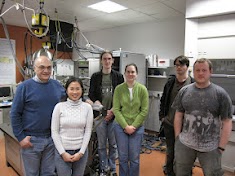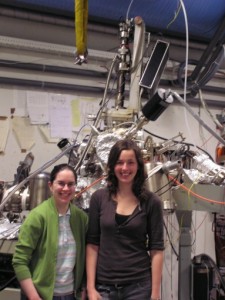Topic: X-ray spectroscopy of two dimensional nanostructured materials
Title of research group: Surfaces and Interfaces Laboratory.
Principal Investigator: Tony Cafolla
Institution: Dublin City University
School/Centre: Physical Sciences / National Centre for Sensor Research (NCSR)
Research: The aim of our research is to study the reactions of small molecules on metal surfaces using a combination of scanning tunnelling microscopy (STM) and synchrotron based x-ray spectroscopy. Our early studies were of transition metal (TM) porphyrin molecules on metal and semiconductor surfaces. The aim of this research is to develop methodologies for the formation of covalently bonded porphyrin nano-networks and nano-lines. The objective is to produce functionalised surfaces for nanolithography and sensor applications. This work resulted in the first observation of an intermediate state in porphyrin molecules on metal surfaces and Ni-Cu ion exchange in Ni-porphyrin molecules on Cu surfaces. More recently we have applied the methodologies developed for the formation of covalent porphyrin nanostructures to the formation of graphene nanoribbons (GNRs). Our research now concentrates on studies of functionalised GNRs and their applications. We use synchrotron radiation in order to characterise our materials via X-ray photoelectron and X-ray absorption spectroscopy.
Techniques: X-ray Photoelectron Spectroscopy (XPS), X-ray Absorption Spectroscopy (XAS/NEXAFS)
Facilities: MAXLAB (Lund), Astrid (Aarhus)
Beamlines: D1011, MAXLAB; SX700, SGM, MatSci, Astrid
Participating group members at SR facilities (period 2008-2014):
PDRAs: Sergey Krasnikov, John Cunniffe
PGs: Claire Hanson, Catherine Doyle, Hooi Ling Lee, John-Patrick Beggan, Tom Carpy
Publication Highlights:
1) K.A. Simonov, N.A. Vinogradov, A.S. Vinogradov, A.V. Generalov, E.M. Zagrebina, N. Mårtensson, A.A. Cafolla, T. Carpy, J.P. Cunniffe, and A.B. Preobrajenski. Effect of Substrate Chemistry on the Bottom-Up Fabrication of Graphene Nanoribbons: Combined Core-Level Spectroscopy and STM Study J.Phys.Chem. C, 118 (2014), 12532.
2) B.E. Murphy, S.A. Krasnikov, N.N. Sergeeva, A.A. Cafolla, A.B. Preobrajenski, A.N. Chaika, O. Lübben, and I.V. Shvets, Homolytic Cleavage of Molecular Oxygen by Manganese Porphyrins Supported on Ag(111). ACS Nano, 8 (2014), 5190.
3) C.M. Doyle, J.P. Cunniffe, S.A. Krasnikov, A.B. Preobrajenski, Z. Li, N.N. Sergeeva, M.O. Senge, A.A. Cafolla, Ni-Cu ion exchange in Ni(II) metallated porphyrins on Cu(111). Chemical Communications 50 (2014) 3447
4) J.P. Beggan, S.A. Krasnikov, N.N. Sergeeva, M.O. Senge, A.A. Cafolla: Control of the axial coordination of a surface-confined manganese(III) porphyrin complex Nanotechnology 23 (2012) 235606
5) S.A.Krasnikov, C.M. Doyle, N.N. Sergeeva, A.B. Preobrajenski, N.A. Vinogradov, Y.N. Sergeeva, A.A. Zakharov, M.O.Senge, A.A. Cafolla: Formation of extended covalently bonded Ni porphyrin networks on the Au(111) surface: Nano Research 4(2011) 376.
6) C.M.Doyle, S.A.Krasnikov, N.N. Sergeeva, A.B. Preobrajenski, N.A. Vinogradov, Y.N. Sergeeva, M.O. Senge, A.A. Cafolla: Evidence for the formation of an intermediate complex in the direct metalation of tetra(4-bromophenyl)-porphyrin on the Cu(111) surface. Chem. Comm. 47 (2011) 12134.
Web site: https://www4.dcu.ie/physics/materials-growth-and-characterisation.shtml


